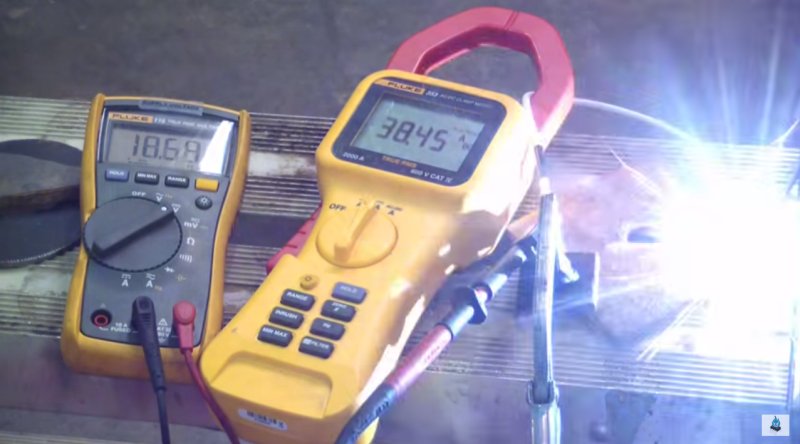The self-proclaimed and actual “smartest idiot on YouTube” is back with another entry from the “don’t try this at home” file. [AvE] recently did a teardown of a new DeWalt cordless drill-driver, and after managing to get everything back together, he was challenged by a viewer to repurpose the 20V battery packs into an impromptu stick welder.
 [AvE] delivered – sort of. His first attempt was with the two battery packs in parallel for higher current, but he had trouble striking an arc with the 1/8″ rod he was using. A freeze-frame revealed an incredible 160A of short-circuit current and a welding rod approaching the point of turning into plasma. Switching to series mode, [AvE] was able to strike a reasonable arc and eventually lay down a single splattery tack weld, which honestly looks better than some of our MIG welds. Eventually his rig released the blue smoke, and the postmortem teardown of the defunct packs was both entertaining and educational.
[AvE] delivered – sort of. His first attempt was with the two battery packs in parallel for higher current, but he had trouble striking an arc with the 1/8″ rod he was using. A freeze-frame revealed an incredible 160A of short-circuit current and a welding rod approaching the point of turning into plasma. Switching to series mode, [AvE] was able to strike a reasonable arc and eventually lay down a single splattery tack weld, which honestly looks better than some of our MIG welds. Eventually his rig released the blue smoke, and the postmortem teardown of the defunct packs was both entertaining and educational.
While we can’t recommend destroying $100 worth of lithium-ion battery packs for a single tack weld, it’s interesting to see how much power you’re holding in the palm of your hand with one of these cordless drills. We saw a similar technique a few years back in a slightly more sophisticated build; sadly, the YouTube video in that post isn’t active anymore. But you can always stay tuned after the break for the original [AvE] DeWalt teardown, wherein blue smoke of a different nature is released.
















The problem is batteries are pretty much a constant voltage source and for stick welding you need a constant current source. Adding a reactor (Welding speak for inductor) in series will help somewhat. There is at least one company that makes a little wire feeder that you can hook to two car batteries in series to do MIG/MAG welding. It is basically a little spool gun. This works because MIG/MAG is a constant voltage weld process.
Entirely possible that I’m forgetting something, but batteries provide pure DC. What sort of inductor creates reactance in that case? I do understand that DC welders that rectify AC line current will use an series inductor to smooth out the the DC. In a way helping provide a constant current DC output.
An arc is an AC load (white noise).
When the weld rod hits the metal the voltage at the load end drops and the inductor charges with magnetism. When the rod then slightly moves away from the metal (as a result of the rod shortening as it melts) the magnetic field in the inductor collapses adding voltage to the load end (above the battery voltage) causing (or sustaining) an arc. This process repeats at high frequency in a spectrum that could loosely be called white noise.
In this way the inductor becomes a dynamic impedance in series with the load (due to the varying frequencies of the white noise) and in effect causes the supply to be more like a constant current supply due to the varying combined load.
Wow, nicely put!
This comment was so well written. Thank you.
They just use a giant choke. Like you said, it helps smooth out the current changes and makes it easier to weld. They are also used on CV machine (Mig) where they are often adjustable to set the slope, the V/A curve of the output. I used to be a Miller tech. I have had cases where people were complaining about poor welds or bad cuts with a plasma cutter and the whole problem is they had the leads spooled up around a metal spool on their truck, the added impedance was enough to mess things up.
http://readywelder.com/ I first saw one of these when a guy came out to weld a platform to the back of our aluminum-hulled house boat for an HVAC compressor. I was impressed with how well it worked, but the “burn time” is pretty short, even for 4 car batteries (series/parallel arrangement).
I have one of those battery powered mig welders, A Broco GoWeld. It’s been a lifesaver. I have welded with my golf cart many times. I have welded aluminum up to 3/8″, Stainless and steel. Primarily I use with flux core as lugging bottles of gas around makes it a lot less portable.
Some time ago Tim Anderson posted quite a few instructables covering improvised welding. One coveried converting a commercial mig spool gun into a battery powered welder.
Video is not related.
Hey, don’t get personal, maybe it’s adopted.
For this price you could get a cheap Chinese stick welder.
Seems like it would be extremely dangerous to dump that much current out of a lithium battery all at once.. I mean those things do catch fire and explode on a whim.